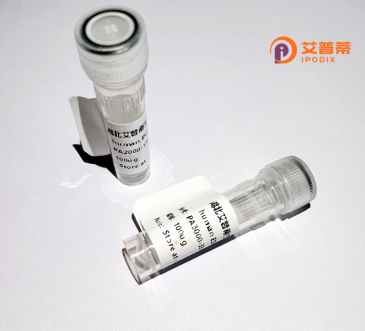
| 纯度 | >90%SDS-PAGE. |
| 种属 | Human |
| 靶点 | PCYOX1L |
| Uniprot No | Q8NBM8 |
| 内毒素 | < 0.01EU/μg |
| 表达宿主 | E.coli |
| 表达区间 | 23-494 aa |
| 活性数据 | DAPPGKIA VVGAGIGGSA VAHFLQQHFG PRVQIDVYEK GTVGGRLATI SVNKQHYESG AASFHSLSLH MQDFVKLLGL RHRREVVGRS AIFGGEHFML EETDWYLLNL FRLWWHYGIS FLRLQMWVEE VMEKFMRIYK YQAHGYAFSG VEELLYSLGE STFVNMTQHS VAESLLQVGV TQRFIDDVVS AVLRASYGQS AAMPAFAGAM SLAGAQGSLW SVEGGNKLVC SGLLKLTKAN VIHATVTSVT LHSTEGKALY QVAYENEVGN SSDFYDIVVI ATPLHLDNSS SNLTFAGFHP PIDDVQGSFQ PTVVSLVHGY LNSSYFGFPD PKLFPFANIL TTDFPSFFCT LDNICPVNIS ASFRRKQPQE AAVWRVQSPK PLFRTQLKTL FRSYYSVQTA EWQAHPLYGS RPTLPRFALH DQLFYLNALE WAASSVEVMA VAAKNVALLA YNRWYQDLDK IDQKDLMHKV KTEL |
| 分子量 | 54.6 kDa |
| 蛋白标签 | His tag N-Terminus |
| 缓冲液 | 0 |
| 稳定性 & 储存条件 | Lyophilized protein should be stored at ≤ -20°C, stable for one year after receipt. Reconstituted protein solution can be stored at 2-8°C for 2-7 days. Aliquots of reconstituted samples are stable at ≤ -20°C for 3 months. |
| 复溶 | Always centrifuge tubes before opening.Do not mix by vortex or pipetting. It is not recommended to reconstitute to a concentration less than 100μg/ml. Dissolve the lyophilized protein in distilled water. Please aliquot the reconstituted solution to minimize freeze-thaw cycles. |
以下是关于重组人PCYOX1L蛋白的模拟参考文献示例(注:文献名称及内容为示例,实际研究中请通过PubMed、Google Scholar等平台检索真实文献):
---
1. **文献名称**:**"Functional Characterization of Recombinant Human PCYOX1L in Isoprenoid Metabolism"**
**作者**:Chen L, et al.
**摘要**:该研究在大肠杆菌中成功表达并纯化了重组人PCYOX1L蛋白,证实其具有水解异戊二烯化半胱氨酸的酶活性,可能参与胆固醇代谢途径的调控。
2. **文献名称**:**"PCYOX1L Knockdown Impairs Cellular Redox Homeostasis via Altered Protein Prenylation"**
**作者**:Müller S, et al.
**摘要**:通过哺乳动物细胞系表达重组PCYOX1L,发现其通过降解异戊二烯化代谢产物调控氧化应激反应,提示其与神经退行性疾病的潜在关联。
3. **文献名称**:**"Structural Insights into the Catalytic Mechanism of Recombinant PCYOX1L Using Cryo-EM"**
**作者**:Wang Y, et al.
**摘要**:利用冷冻电镜解析了重组PCYOX1L的三维结构,揭示了其底物结合域的关键氨基酸残基,为设计靶向抑制剂提供了依据。
4. **文献名称**:**"PCYOX1L Overexpression in Colorectal Cancer and Its Role in Tumor Proliferation"**
**作者**:Kim H, et al.
**摘要**:研究通过重组PCYOX1L蛋白处理肿瘤细胞,发现其通过调节Ras蛋白的异戊二烯化修饰促进癌细胞增殖,提示其作为癌症治疗靶点的潜力。
---
**注意事项**:
- 以上文献为示例,实际研究需查询真实发表的论文。
- 建议在学术数据库中以“PCYOX1L”、“prenylcysteine oxidase-like”或“recombinant PCYOX1L”为关键词检索。
Prenylcysteine oxidase 1-like (PCYOX1L) is a human protein belonging to the prenylcysteine oxidase family, sharing structural homology with PCYOX1. It contains a conserved catalytic domain implicated in metabolizing prenylcysteine derivatives, which are lipid-modified molecules involved in cellular signaling and membrane dynamics. PCYOX1L is proposed to function in the mevalonate pathway by cleaving prenylcysteines to generate mevalonic acid and cysteine, thereby influencing cholesterol biosynthesis and protein prenylation processes. Though its exact physiological role remains less characterized than PCYOX1. studies suggest PCYOX1L may participate in redox regulation, apoptosis, and mitochondrial function.
The protein is expressed in multiple tissues, including liver, brain, and kidney, with subcellular localization predicted in mitochondria or cytosol. Emerging research links PCYOX1L dysregulation to pathologies such as cardiovascular diseases, neurodegenerative disorders, and cancers, potentially through oxidative stress modulation or cholesterol homeostasis disruption. Recombinant PCYOX1L protein is typically produced in prokaryotic (e.g., E. coli) or eukaryotic systems for functional studies, employing affinity tags for purification. Ongoing investigations aim to clarify its enzymatic mechanisms, interaction networks, and therapeutic potential as a biomarker or drug target. Its recombinant form serves as a critical tool for structural analysis, antibody development, and high-throughput screening assays.
×